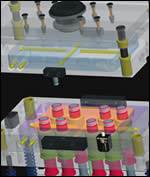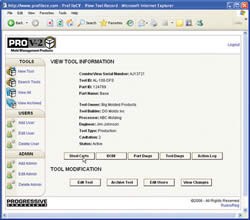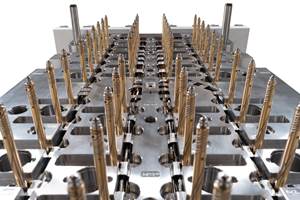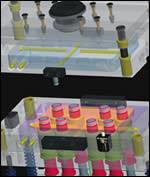Designing for Downstream
Steps can be taken to deliver to your customer not only a better performing tool, but a better performing tooling investment.
A purchase order has been promised by the customer for weeks, and finally the green light has been given to the mold design team. No sooner has the design started and the shop foreman is asking when steel can be ordered, as the shop needs work. The designer is pressing ahead with concurrent actions, as cavities haven’t been fully detailed yet, but there is pressure to provide data for making some chips out on the shop floor. Although the mold’s lifecycle will be a long-running marathon of parts production, the design process is often a sprint.
Within that critical stage before that baby is born, a myriad of decisions are being made that will determine to what degree that mold will be an investment, or to what degree that mold will be a cost. What can be done proactively in order to assure the tool is as reliable and profitable as possible?
Set Standards
For a mold building company serving several customers, mold specs, if they exist, are often ‘light’. Some general guidelines may be given, but much is left to be determined by the individual designer at the particular shop that was awarded the tool.
If a customer has not put together extensive standards, then it may be beneficial for the mold builder to develop a position that states, “Unless otherwise specified, the mold will follow these documented standards.” A sample spec book has been compiled as a starting point for a molder—or even a mold builder—to establish some default decisions. Access this document at http://www.moldmakingtechnology.com/
articles/020703.html as a place to start if extensive guidelines do not already exist.
Think Maintenance
Standard off-the-shelf components have long been preferred for a mold that is easier to maintain and repair. But beyond standard pins and bushings, standard mechanisms have emerged that will make servicing the tool more straightforward for the mold technicians within the injection molding company.
Although a mold designer will typically review whether it will be straightforward for the mold to be disassembled and assembled, an added step can be to review the servicing of individual mold features. For example, can the lifters be checked and serviced without disassembling the entire core half? Can the slides be pulled easily without interference or resistance from the retainers? Are the in-line water diverters removable in order to allow for cleaning of the mold’s cooling circuits?
Someone will have to live with this mold for numerous cleanings and various repairs and revisions, and often standard components allow for intuitive mold maintenance.
Housing Data
Different individuals are in need of different information at different times about that mold. Although data can initially be sent following the mold build, how will that be of use to those at the mold’s eventual destination? How many times has a designer been asked to send the mold drawings?
One method for seamlessly housing mold data for use by authorized individuals later is via an onmold/online combination at www.ProFileCV.com. A unique URL serial number is etched on the mold’s cycle counter (e.g., CounterView). This URL address can serve as a free, secure location for storing the mold’s profile. This profile can include mold drawings, part drawings, the bill of materials, steel certifications, as well as added notes such as mold disassembly/assembly instructions. Rather than information vulnerably traveling with the mold, this combination of an ID on the tool that leads to a secure yet accessible file cabinet can prevent confusion and chase work for wherever that mold may travel over its lifetime.
It may be an extra step at the final mold design stage, but for all involved it may be a timesaver to have key mold data available on demand.
A Differentiation Advantage
A lot of companies can build a mold. But while most may rush to begin cutting steel, a differentiation can be made by the mold builder who, at the design stage, also focused on the mold’s life downstream.
Through extensive forethought, steps can be established that deliver to the customer not only a better performing tool, but a better performing tooling investment.
Related Content
MMT Chats: The Connection Between Additive Manufacturing Education and ROI
This MMT Chat continues the conversation with Action Mold and Machining, as two members of the Additive Manufacturing team dig a little deeper into AM education, AM’s return on investment and the facility and equipment requirements to implement AM properly.
Read MoreHow to Use Scientific Maintenance for More Accurate Mold and Part Troubleshooting
Discover how adopting scientific maintenance approaches helps improve mold lifespan, minimize failures, and optimize production outcomes.
Read MoreQuestions and Considerations Before Sending Your Mold Out for Service
Communication is essential for proper polishing, hot runner manifold cleaning, mold repair, laser engraving and laser welding services.
Read MoreHow to Solve Hot Runner Challenges When Molding with Bioresins
A review of the considerations and adaptations required to design hot runners and implement highly productive injection molding operations.
Read MoreRead Next
Don’t Build the “Same Old Same Mold”
Steps for evaluating the latest mold innovations in order to move along the evolution process.
Read MoreHow to Use Continuing Education to Remain Competitive in Moldmaking
Continued training helps moldmakers make tooling decisions and properly use the latest cutting tool to efficiently machine high-quality molds.
Read MoreHow to Use Strategic Planning Tools, Data to Manage the Human Side of Business
Q&A with Marion Wells, MMT EAB member and founder of Human Asset Management.
Read More























